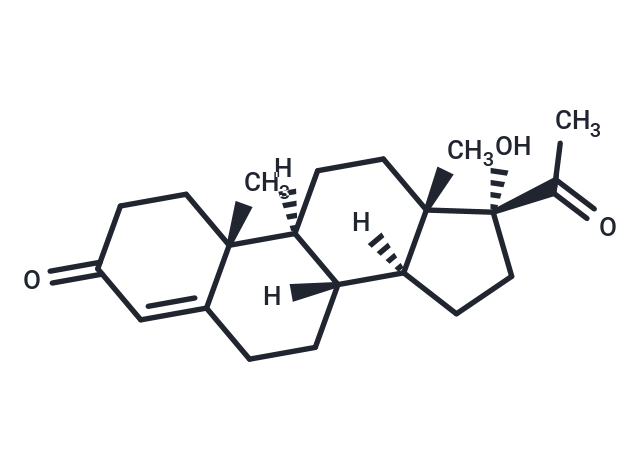Shopping Cart
- Remove All
 Your shopping cart is currently empty
Your shopping cart is currently empty

17α-Hydroxyprogesterone (17-OHP) is a physiological progestin that is produced during glucocorticoid and steroid hormone synthesis and is increased during the third trimester of pregnancy. Hydroxyprogesterone binds to the cytoplasmic progesterone receptors in the reproductive system and subsequently activates progesterone receptor-mediated gene expression.

| Pack Size | Price | Availability | Quantity |
|---|---|---|---|
| 1 g | $29 | In Stock | |
| 1 mL x 10 mM (in DMSO) | $29 | In Stock |
| Description | 17α-Hydroxyprogesterone (17-OHP) is a physiological progestin that is produced during glucocorticoid and steroid hormone synthesis and is increased during the third trimester of pregnancy. Hydroxyprogesterone binds to the cytoplasmic progesterone receptors in the reproductive system and subsequently activates progesterone receptor-mediated gene expression. |
| In vitro | 17α-Hydroxyprogesterone is an agonist of the progesterone receptor (PR) similarly to progesterone, albeit weakly in comparison[1]. It is a chemical intermediate in the biosynthesis of steroid hormones, including the androgen and estrogen sex hormones and the glucocorticoids and mineralocorticoids. |
| In vivo | 17-Hydroxyprogesterone is a potent steroid inducer of GVBD (germinal vesicle breakdown)[3]. |
| Alias | Hydroxyprogesterone, 17-OHP, 17-Hydroxyprogesterone |
| Molecular Weight | 330.46 |
| Formula | C21H30O3 |
| Cas No. | 68-96-2 |
| Smiles | C[C@@]12[C@]([C@]3([C@@]([C@]4(C)C(CC3)=CC(=O)CC4)(CC1)[H])[H])(CC[C@@]2(C(C)=O)O)[H] |
| Relative Density. | 1.15 g/cm3 |
| Storage | Powder: -20°C for 3 years | In solvent: -80°C for 1 year | Shipping with blue ice/Shipping at ambient temperature. | |||||||||||||||||||||||||||||||||||
| Solubility Information | DMSO: 50 mg/mL (151.3 mM), Sonication is recommended. Ethanol: 61 mg/mL (184.59 mM), Sonication is recommended. | |||||||||||||||||||||||||||||||||||
Solution Preparation Table | ||||||||||||||||||||||||||||||||||||
DMSO/Ethanol
| ||||||||||||||||||||||||||||||||||||

Copyright © 2015-2025 TargetMol Chemicals Inc. All Rights Reserved.